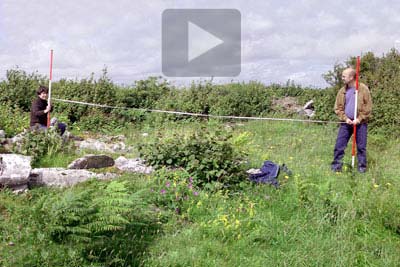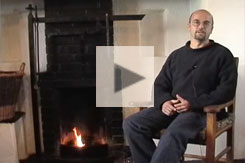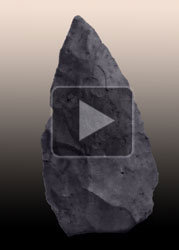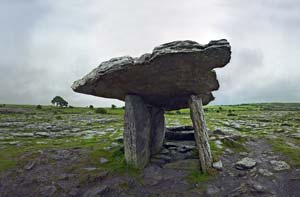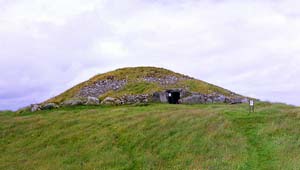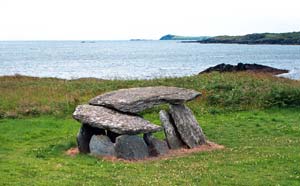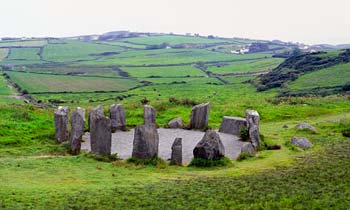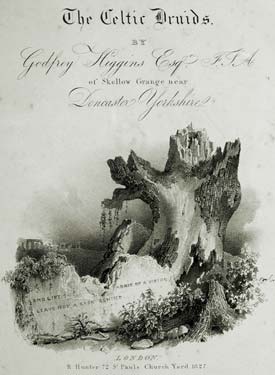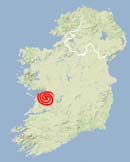The megalithic monuments of Ireland are usually categorized by architectural style into court tombs, portal tombs, passage tombs, and wedge tombs. Other megalithic monuments, some also connected with burial rituals, include standing stones and stone circles. Some of the megalithic tombs may not conform completely to a single category, since through the millennia a monument may have undergone transformations by different generations who each used it for their own purposes.29 These monuments, built of large stones, required teams of community members working together in an organized fashion. Since many more people were required to build a tomb than could possibly be buried within it, only some, presumably important individuals, were allotted burial spaces. While the stones used in the tomb construction were rough and unworked, their positioning was carefully considered, usually with an alignment to the rising or setting sun on a particular day of the year.
The court tombs, the portal tombs, and the early small passage tombs all began appearing in the Early to Middle Neolithic periods (c. 4000-3500 BCE). The largest passage tombs, built in the Late Neolithic, were followed by the construction of wedge tombs, which continued into the Bronze Age.
The building of megalithic monuments came to an end in Ireland some time around 1800 BCE. There were at least two factors involved: one was a profound climate change that proved disastrous to agriculture and may have upset a long-establish belief system involving the veneration of tribal ancestors. Ireland, which at the start of the Neolithic (c. 5000 BCE) had a climate similar to today’s south of France, slowly but consistently grew colder and wetter at about the time of the end of megalith construction. By 1400 BCE the trend grew much more severe, turning marginal farmland into moors and bogs useless for agriculture. The last megalithic tomb built in Ireland may have been a wedge tomb constructed in the centuries just after 2000 BCE.30
At the same time the small clan-based social structures of the Neolithic were evolving into the larger and more organized societies of the Late Bronze Age (c. 1000-600 BCE) with groups centered around chiefs and regional kings. One exception might have been the passage tombs of Brú na Bóinne, built around 3000 BCE. These massive engineering projects could only be built by cultures with a level of social organization perhaps two millennia ahead of the rest of the country.31
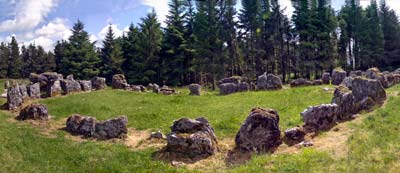
Deerpark Court Tomb, Co. Sligo
Court Tombs
These tombs consisted of a long stone cairn, with the semi-circular arms of a “court” leading out from the wider end. Deerpark Court Tomb, in Co. Sligo, is one example (left). The cairn’s entrance led to a stone chamber containing the burial(s). Ireland has some 400 of these, most in the northern third of the island.32 While other types of Irish megalithic monuments also occur in Britain, on the Continent, and elsewhere around the globe, court tombs are found only in Ireland. The axis of the tomb generally runs west to east, with the opening to the burial chamber facing east. It is presumed that the court was where rituals were held during the burial activity or in later commemorative practices. Some examples have two forecourts, at opposite ends of a long cairn, with each court leading to its own burial chambers.33 The chambers of court tombs contained either buried or cremated remains, along with pottery, animal bones, and stone tools. Over the millennia most court tombs have been pilfered for their mounds of stone, so that only the supporting side stones remain.
The small tribal cultures responsible for the court tombs used them as sacred sites for many centuries. The descendants of those interred visited the sites for ritual observances, perhaps tied to seasonal changes. There may have been shamans who actually entered the tombs to interact with the bones in an effort to persuade the ancestors to intervene in the lives of their progeny. Carleton Jones noted:

